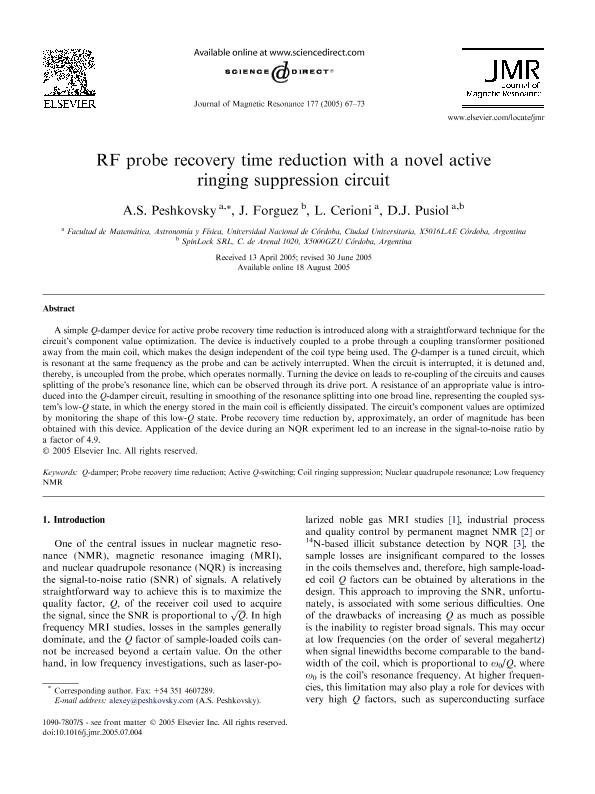Mostrar el registro sencillo del ítem
dc.contributor.author
Peshkovsky, Alexey S.
dc.contributor.author
Forguez, J.
dc.contributor.author
Cerioni, Lucas Matias Ceferino

dc.contributor.author
Pusiol, Daniel Jose

dc.date.available
2020-09-25T22:08:46Z
dc.date.issued
2005-11
dc.identifier.citation
Peshkovsky, Alexey S.; Forguez, J.; Cerioni, Lucas Matias Ceferino; Pusiol, Daniel Jose; RF probe recovery time reduction with a novel active ringing suppression circuit; Academic Press Inc Elsevier Science; Journal Of Magnetic Resonance; 177; 1; 11-2005; 67-73
dc.identifier.issn
1090-7807
dc.identifier.uri
http://hdl.handle.net/11336/114916
dc.description.abstract
A simple Q-damper device for active probe recovery time reduction is introduced along with a straightforward technique for the circuit's component value optimization. The device is inductively coupled to a probe through a coupling transformer positioned away from the main coil, which makes the design independent of the coil type being used. The Q-damper is a tuned circuit, which is resonant at the same frequency as the probe and can be actively interrupted. When the circuit is interrupted, it is detuned and, thereby, is uncoupled from the probe, which operates normally. Turning the device on leads to re-coupling of the circuits and causes splitting of the probe's resonance line, which can be observed through its drive port. A resistance of an appropriate value is introduced into the Q-damper circuit, resulting in smoothing of the resonance splitting into one broad line, representing the coupled system's low-Q state, in which the energy stored in the main coil is efficiently dissipated. The circuit's component values are optimized by monitoring the shape of this low-Q state. Probe recovery time reduction by, approximately, an order of magnitude has been obtained with this device. Application of the device during an NQR experiment led to an increase in the signal-to-noise ratio by a factor of 4.9.
dc.format
application/pdf
dc.language.iso
eng
dc.publisher
Academic Press Inc Elsevier Science

dc.rights
info:eu-repo/semantics/openAccess
dc.rights.uri
https://creativecommons.org/licenses/by-nc-sa/2.5/ar/
dc.subject
ACTIVE Q-SWITCHING
dc.subject
COIL RINGING SUPPRESSION
dc.subject
LOW FREQUENCY NMR
dc.subject
NUCLEAR QUADRUPOLE RESONANCE
dc.subject
PROBE RECOVERY TIME REDUCTION
dc.subject
Q-DAMPER
dc.subject.classification
Otras Ciencias Físicas

dc.subject.classification
Ciencias Físicas

dc.subject.classification
CIENCIAS NATURALES Y EXACTAS

dc.title
RF probe recovery time reduction with a novel active ringing suppression circuit
dc.type
info:eu-repo/semantics/article
dc.type
info:ar-repo/semantics/artículo
dc.type
info:eu-repo/semantics/publishedVersion
dc.date.updated
2020-09-21T14:49:13Z
dc.journal.volume
177
dc.journal.number
1
dc.journal.pagination
67-73
dc.journal.pais
Estados Unidos

dc.description.fil
Fil: Peshkovsky, Alexey S.. Universidad Nacional de Córdoba. Facultad de Matemática, Astronomía y Física; Argentina
dc.description.fil
Fil: Forguez, J.. No especifíca;
dc.description.fil
Fil: Cerioni, Lucas Matias Ceferino. Universidad Nacional de Córdoba. Facultad de Matemática, Astronomía y Física; Argentina. Consejo Nacional de Investigaciones Científicas y Técnicas; Argentina
dc.description.fil
Fil: Pusiol, Daniel Jose. Consejo Nacional de Investigaciones Científicas y Técnicas. Centro Científico Tecnológico Conicet - Córdoba. Instituto de Física Enrique Gaviola. Universidad Nacional de Córdoba. Instituto de Física Enrique Gaviola; Argentina
dc.journal.title
Journal Of Magnetic Resonance

dc.relation.alternativeid
info:eu-repo/semantics/altIdentifier/url/https://www.sciencedirect.com/science/article/abs/pii/S1090780705002284
dc.relation.alternativeid
info:eu-repo/semantics/altIdentifier/doi/http://dx.doi.org/10.1016/j.jmr.2005.07.004
Archivos asociados
